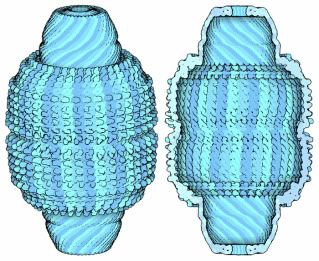I'm still vaguely searching for a good free spectrogram-to-sound program, but this Sound to Graph to Sound Java applet is a good start.
The default resolution is pretty low, but if you're not interested in any of their demo sounds and just feel like doodling, you can hit the reset button to adjust some of the parameters. You can increase the resolution to MxN = 448x448, and to get the frequency bounds closer to vocal range I'd set FL to 10, keeping FH at 4000 (or possibly changing to 8000). You can also increase the value of NFRAME, which lets you store multiple sounds which you can navigate through with the arrow keys, or check the animate box to play them in sequence.
Mostly so far I have succeeded in making lots of drawings that all sound like frogs. Curious.
Saturday, July 4, 2009
Friday, July 3, 2009
Protein Vaults

Vaults are the Protein Data Bank's molecule of the month. Nerdy, yes, but these sound kind of cool:
Vaults are composed of many copies of the major vault protein, which assembles to form a hollow football-shaped shell. The one shown here is from rat liver cells (PDB entries 2zuo, 2zv4, and 2zv5) and contains 78 copies of the protein. Inside cells, the vault also encloses a few other molecules, which were not seen in the crystal structure because they don't have a symmetrical structure inside the vault. These molecules include several small RNA molecules, a protein that binds to RNA, and an enzyme that adds nucleotides to proteins.
Labels:
compbio
23 Questions
Darpa's 23 mathematical challenges in modern scientific efforts, with a distinct emphasis on computational biology.
Larry Abbott's 23 questions in computational neuroscience.
23 is a reference to the father of all such lists, Hilbert's 23 problems posed to the International Congress of Mathematicians in 1900; these problems shaped much of 20th century mathematics, and some remain unresolved to this day.
Larry Abbott's 23 questions in computational neuroscience.
23 is a reference to the father of all such lists, Hilbert's 23 problems posed to the International Congress of Mathematicians in 1900; these problems shaped much of 20th century mathematics, and some remain unresolved to this day.
Labels:
compbio,
computing,
mad science,
math,
neuroscience,
research
Subscribe to:
Posts (Atom)